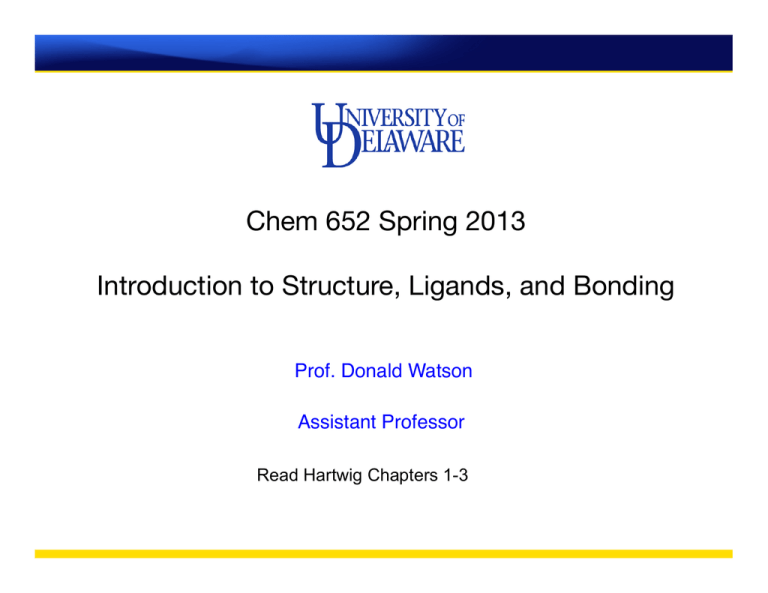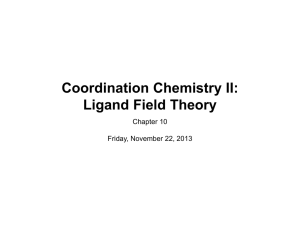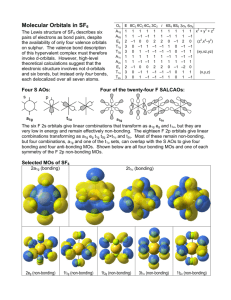Document 10755093
advertisement

Chem 652 Spring 2013 Introduction to Structure, Ligands, and Bonding Prof. Donald Watson " Assistant Professor" " " Read Hartwig Chapters 1-3 General Anatomy of an Organometallic Complex CO Fe Examples from last time: tBu OC PPh2 Cl PPh3 Ir OC CO CO OC Cl Ta Ph2P Ph3P Ni O tBu Ph3P OC O Ir Cl Cl Cl HH H In general: • Organometallic complexes are comprised of one or more metal atoms supported by one or more ligands. • We will focus primarily on soluble transition metal complexes and intermediates in this class. • To understand reactivity, must consider: • Type of metal (element) • Formal number of electrons around the metal. • Type and Number of Ligands • Charge of Complex • Shape of Complex CO CO Pt Cl PPh3 Fe H (+, 0, –, etc) L L L M L L L “Transition Metals” M st 0 1 row nd 2 row rd 3 row III 3 d Sc Y La early IV 4 d Ti Zr Hf V 5 d V Nb Ta VI 6 d Cr Mo W VII 7 d Mn Tc Re dividing line • Group XII do not meet Cotton and Wilkinson’s definition of transition metals “partially filled d-orbitals” • Assumption: for metals in metal complexes assume all valence electrons are in the d-orbitals e.g. Rh s2d7 actually d9; Sc 3s2d1 actually d3 VIII 8 d Fe Ru Os IX 9 d Co Rh Ir X 10 d Ni Pd Pt late XI d s Cu Ag Au 10 1 XII 10 2 d s Zn Cd Hg Sweeping Stereotypes Early metals high oxidation states dominate Ti(0) → Ti4+ easy! Late metals low oxidation states dominate hard ligands tend to be favored less polarizable (Cl–; O2–) :NH3 harder than :PR3 soft ligands more favored more electropositive less electropositive M–L bonds have more ionic character important for M–C bonds M-L bonds have more covalent character for M–C bonds ex. Zr(CH2Ph)4 less typical [V(CO)6]– Important Periodic Trends to Keep in Mind • • • • size decreases → size increases ↓ (1st to 2nd) sze stays approx. the same 2nd to 3rd redox states: (1) ability to oxidize increases ↓ (2) covalency increases ↓ • 3d often too small for good M–C overlap, 4d and 5d much better. Result? 2nd row elements are often important catalysts! Orbitals: 3s http://winter.group.shef.ac.uk/orbitron/AOs/3d/index.html Orbitals: 3p http://winter.group.shef.ac.uk/orbitron/AOs/3d/index.html Orbitals: 3d z dx2-y2 dz2 y on axis (Oh) x dxy L L L M dxz dyz L L off axis (Oh) L http://winter.group.shef.ac.uk/orbitron/AOs/3d/index.html Orbitals: 4d http://winter.group.shef.ac.uk/orbitron/AOs/3d/index.html 18 Electron “Rule” Many, but not all, stable, isolatable TM complexes are 18e– complexes. Why? Simple Answer: TM Valance Orbitals: 1 x nS orbital, 3 x nP orbitals, 5 x (n-1)D orbitals = 9 total valance orbitals = 18e– for close shell valance Real Answer: More complex… as we are dealing with complexes, not metal atoms… more to come on this. NOTE: 18e– “rule” is more of a suggestion. Many of the most interesting, i.e. reactive, complexes do not follow this “rule”. Determining Electron Count of TM Complex Two methods for counting electrons around metal center (ionic and covalent). Electron counting is a formalism. Covalent Method: All ligands are disassociated as neutral ligands. L-type ligands = neutral, 2 e- donor X-type ligands = neutral radical, 1 e- donor X n X L M n L L M X X L Example of Covalent Method Electron Counting H O C H OC OC Fe H CO O C Fe0 CO C O 4 X CO 2 X H· Fe(0) (d8) 4 X 2e2 X 1e- 8e2e8e- ________________________________________ 18e- H C O Ionic Method of Electron Counting Covalent Method: All ligands are disassociated with their electrons ligands. L-type ligands = neutral, 2 e- donor X-type ligands = anionic 2 e- donor n X X L M n+y L L M X X mnemonic: X L M X X L L M+ L X– L where y = number of x-type ligands Example of Ionic Method Electron Counting H– O C H OC OC Fe H CO O C Fe2+ CO C O 4 X CO 2 X H– Fe(2+) (d6) 4 X 2e2 X 2e- C O H– 8e4e6e- ________________________________________ 18e- Note: Both Ionic and Neutral Methods give the same electron count, but differ in how they treat the metal center. Charged Complexes 2– 2K+ Cl Cl Pd Cl Covalent: 4 X Cl· 4 X 1ePd(2-) (d10+2) 4e12e- ________________________________________ 16e- Cl Ionic: 4 X ClPd(2+) (d8) 4 X 2e- 8e8e- ________________________________________ 16e- Oxidation State • Formalism to account for “oxidation state” of metal center. • This is only a formalism, in reality electrons (and thus charge) are shared over both the ligand and metal. • None the less, oxidation state guides understanding of metal reactivity. • Using ionic method of electron counting arrives directly at metal oxidation state. • Example: H OC OC Fe H CO CO Oxidation State = Fe(II) Ionic: 4 X CO 2 X H– Fe(2+) (d6) 4 X 2e2 X 2e- 8e4e6e- ________________________________________ 18e- Formalism in Action • Recall this is oxidation state is formalism! • Analysis describes H2Fe(CO)4 as Fe(II), suggesting hydridic H’s (H–). • Note: this is consistent with electronegativity (H = 2.1; Fe = 1.8). • However: H2Fe(CO)4 + H2O HFe(CO)4– + H3O+ acidic, not hydridic! pka ~ 5 • Lesson: Need to think about the whole complex, not just metal salts. δ+ δ- Fe H Examples of X-type Ligands Ligand Disconnection Complex ligand charge ligand e- hydride M H M+ + H -1 2 halide M Cl M+ + Cl -1 2 alkyl M CR3 M+ + CR3 -1 2 aryl (σ bound) M M+ + -1 2 -1 2 M+ + acetylide M silane M SiR3 M+ + SiR3 -1 2 amido M NR2 M+ + NR2 -1 2 alkoxide M OR M+ + OR -1 2 R R Simple Bonding Picture metal-hydride σ* E dx2-y2 1s σ M H Simple Bonding Picture metal-halide σ* E dx2-y2 3p σ M Cl Simple Bonding Picture M CR3 M M R σ* E dx2-y2 sp, sp2, or sp3 hybrid σ M R Examples of X-type Ligands (More Complex) Ligand Disconnection Complex O acetate (η1) acetate (η3) allyl (η1) allyl (η3) cyclopentadienyl (Cp) M O M M M ligand e- O Me O M ligand charge Me M+ + -1 2 -1 4 M+ + -1 2 M+ + -1 4 -1 6 M+ + O Me O O Me O M+ + • 𝜼 (eta) denotes “hapticity” = how many atoms of ligand are bond to metal from single donor site. Examples of 2e– Donor “L”-type Ligands ligand charge ligand e- PPh3 0 2 M+ NEt3 0 2 M+ N CR 0 2 0 2 0 2 0 2 0 2 0 2 Ligand Complex Disconnection phopshine M PPh3 M+ amine M NEt3 nitrile M N CR H sigma bond (H–H) sigma bond (C–H) H M M+ H H H H M M+ CR3 alkene CR3 M+ M carbonyl M C ether M OR2 O M+ C M+ OR2 O Bonding Picture Simple σ donors. σ* E dx2-y2 sp3 σ M PR3 Bonding Picture dihydrogen H H σ* E dx2-y2 H = H σ (H-H) σ H H H M H H H Bonding Picture C-H σ bond σ* E dx2-y2 H C σ (C-H) σ H M CR3 Bonding Picture Alkenes - Bonding σ* E dx2-y2 (or dz2) π (C-C) σ M Bonding Picture Alkenes – “Back-Bonding” π* E dxz π∗ (C-C) (or dxy) π M • “Back bonding” occurs if there is a filled (or partially) d-orbital with correct symmetry to overlap empty ligand orbital. • Filled d-orbital depends on metal and electron-count. Bonding Picture Back bonding: σ* π* dxz dx2-y2 E π∗ (C-C) π π (C-C) σ R R M R R π complex • Increases metal-ligand bond order. • Decreases C=C character (populating π*). • Increases sp3 character of alkene carbons. • Think of as resonance with metallocyclopropane. Zeiss Salt R R M Cl Cl R R metallocyclopropane Cl HH Pt H H yellow crystals C O C O Bonding Picture Carbon Monoxide 2π 2 π* σ* E dx2-y2 sp (or dz2) σ M CO C O Bonding Picture C O Carbon Monoxide 2π 2 π* π* E π* E dxz dxy π∗ (C-O) π∗ (C-O) π M CO π M CO C O C O Bonding Picture Carbon Monoxide 2π 2 π* σ* π* π∗ (C-C) dx2-y2 E sp (or dz2) π σ M CO “L”-type Ligands Donating More than 2e– Ligand Disconnection Complex diene M ligand charge ligand e- M+ 0 4 arene (η6) M M+ 0 6 arene (η2) M M+ 0 2 0 4 Ph Ph Ph P bisphosphine (κ2) Ph P M+ M P Ph Ph Ph Ph R R R R N diamine (κ2) 2 X 2e– L-type ligands P N M+ M P R R 4 2 X 2e– L-type ligands N R 0 R • 𝜅 (kappa) denotes “denticity” = how many binding sites of a polydentate ligand are bound . Singlet Carbenes and NHC-Ligands Ligand Disconnection Complex R N N-heterocyclic carbenes Fisher Carbene ligand charge R N M M+ N R 0 2 0 2 N R O R O R M M+ R R Sigma Bond Pi-Backbond R M ligand e- N C N R M C N N Bridging Ligands Ligand Disconnection Complex Cl M µ-bridged ligand charge Cl M M Cl 1X neutral, 2 e1X anionic, 2 e- M Cl σ* σ* E ligand e- dx2-y2 E dx2-y2 p (Cl) 3p σ σ M Cl • µ (mu) denotes bridging ligands. M Cl M' Bridging Ligands Bridging CO O O M C M M M 1 e- neutral donor to each metal O C O C σ donation π backbonding Bridging Ligands Bridging Hydride M H H H M hydride has only 2 e–! M M M M treat as one X type and one L type Metal-Metal Bonds Complex Disconnection "ligand" charge "ligand" e- M M M M 0 1 M M M M 0 2 etc.... Bonding Picture δ* E δ M M Shape depends on orbitals involved… can be “delta” bonding. XL Ligands π donor ligands M Cl M NR2 halide amido M OR alkoxide π* σ* E E dx2-y2 dxz pCl 3p assuming empty d σ π M Cl M Cl Bonding Picture σ* σ* π* π* E dx2-y2 E dxz dx2-y2 dxz 3p 3p π π σ empty d orbital stabilizing σ filled d orbital (p → d repulsion) destabilizing X2 Ligands Ligand Complex Disconnection 2+ CR2 ligand charge ligand e- -2 4 triplet carbenes (alkylidines) M CR2 M2+ oxo M O M2+ + O -2 4 imido (bent) M N M2+ 2+ NR -2 4 2- R Singlet Carbenes and NHC-Ligands Ligand Disconnection Complex R N N-heterocyclic carbenes Fisher Carbene ligand charge R N M M+ N R 0 2 0 2 N R O R O R M M+ R R Sigma Bond Pi-Backbond R M ligand e- N C N R M C N N Understanding Carbenes Sigma Bond Singlet Carbene M R N C N R Pi-Backbond M C Triplet Carbene (alkylidene) M C R R empty p-orbital stablized by donor atom or group pC nN Sigma-donation H N Pi-donation M C R R treat as filled p-orbital Bonding Picture σ* π* dx2-y2 E E dxz pCl sp2 C σ R R C assuming empty d π M CR2 M CR2 R R Bonding Picture alkylidenes, bent imidos, oxos σ* π* E dx2-y2 dxz 3p sp2 π σ “Triplet” Carbene σ* π* E dx2-y2 dxz 3p π σ Covalent method: neutral, 2e– donor C R R X3 Ligands Ligand Complex carbyne M CR Disconnection M2+ 3+ CR ligand charge ligand e- -3 6 -3 6 3nitrido M N M2+ + N Bonding Picture Very Similar to CO σ* π* E dx2-y2 dxz dxy pz, py sp π σ X2L Ligand Complex M imido (linear) N R Disconnection M2+ + 2NR -2 σ* π* E dx2-y2 dxz dxy pz, py sp π σ ligand charge ligand e6 Consider W(NH3)6 H3N H3N NH3 NH3 W NH3 NH3 Symmetry Adapted Linear Combinations (SALCs) eg 2 nodes t1u 1 node a1g no node d6, 18 electron 6X H N H H Full MO Diagram σ*s (a1g) σ*p (t1u) t1u a1g σ*d (eg) eg nd (t2g) t2g eg t1u σp (t1u) σd (eg) σs (a1g) a1g Adding Electrons σ*s (a1g) σ*p (t1u) t1u a1g σ*d (eg) eg nd (t2g) t2g eg t1u σp (t1u) σd (eg) σs (a1g) a1g Adding Electrons σ*s (a1g) σ*p (t1u) t1u a1g σ*d (eg) eg Δ0 nd (t2g) t2g eg t1u σp (t1u) σd (eg) a1g σs (a1g) • 18 e– required to fill bonding and non-bonding orbitals. Now Consider W(CO)6 CO OC OC CO W CO 6X C O +6X CO +6X d6, 18 electron C O σ-Bonding Picture Unchanged σ*s (a1g) σ*p (t1u) t1u a1g σ*d (eg) t2g eg t2g eg t1u σp (t1u) σd (eg) σs (a1g) a1g π-contributions σ*s (a1g) σ*p (t1u) t1u πd* (t2g) a1g σ*d (eg) t2g eg t2g eg πd (t2g) t1u σp (t1u) σd (eg) σs (a1g) a1g π-contributions σ*s (a1g) σ*p (t1u) t1u πd* (t2g) a1g σ*d (eg) t2g eg Δ0 t2g eg πd (t2g) t1u σp (t1u) σd (eg) a1g σs (a1g) • 18 e– required to fill bonding orbitals. • Δ0 increased with back bonding. Real Origin of the 18 Electron Rule σ*s (a1g) σ*s (a1g) σ*p (t1u) σ*p (t1u) πd* (t2g) σ*d (eg) σ*d (eg) • complexes with strong σdonating and π-accepting ligands more strongly adhere to this rule Δ0 Δ0 nd (t2g) πd (t2g) σp (t1u) σp (t1u) σd (eg) σd (eg) σs (a1g) σs (a1g) W(NH3)6 • in octahedrons: 18 e– fills bonding and non-bonding orbitals W(CO)6 Δ Crystal Field Splitting Term σ*s (a1g) σ*s (a1g) σ*s (a1g) σ*p (t1u) σ*p (t1u) σ*p (t1u) πd* (t2g) σ*d (eg) σ*d (eg) σ*d (eg) Δ0 Δ0 Δ0 πd (t2g) nd (t2g) πd (t2g) σp (t1u) σp (t1u) σp (t1u) σd (eg) σd (eg) σd (eg) σs (a1g) σs (a1g) σs (a1g) W(NH3)6 W(CO)6 [Cr(OH2)6]2+ • Δo is dependent on: (1) ligand (2) T.M. (row) increases ↓ • consequence of (2): high spin v. low spin para- v. diamagnetic Crystal Field Strength I– < Br– < Cl– < OH– < H2O < NH3 << CN– < PR3 < CO σ*s (a1g) σ*p (t1u) t1u πd* (t2g) a1g Largest Δo with: • strong σ-donors (raises eg) • strong π-acceptors (lowers t2g) σ*d (eg) t2g eg t2g eg πd (t2g) t1u σp (t1u) σd (eg) σs (a1g) a1g Relative Energies Of Common Geometries z y x z2 x2-y2 eg x2-y2 a1g z2 E xy xz yz t2g eg xz octahedral (Oh) xy xz z2 yz x2-y2 t2 e yz xy square planar a1 z2 b1g xy x2-y2 e" xz yz b2g tetrahedral (Td) e' trigonal bipyramidal Understanding Trends z y x eg x2-y2 x2-y2 z2 a1g z2 E b1g eg t2g xz xz yz xy yz xy b2g • Removal of ligands on zaxis lowers dz2 MO (recall this is anti-bonding). • How do you explain xy, xz and zy? Does it depend on the ligands? • Explains why d8 16e-, sq. planar are so common… high lying x2-y2. σ*dz2 (eg) σ*dz2 (eg)





